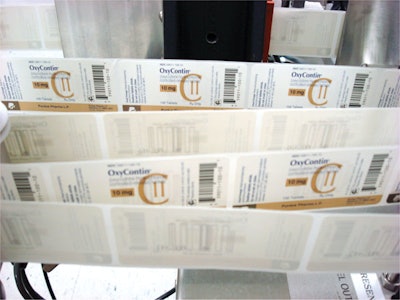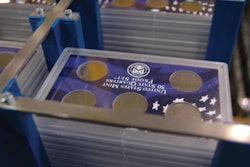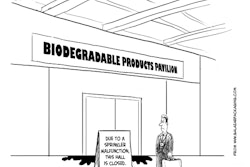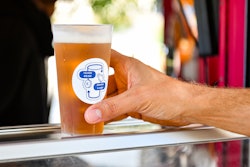Purdue Pharma LP has one of the most visible RFID programs in pharmaceutical manufacturing. “In trying to get an RFID program off the ground, you’re working with an emerging technology, so you want to go in step-wise fashion, with buy-ins from many cross-functional project teams in your company,” said Mike Celentano, associate director of supply chain systems and RFID for Stamford, CT-based Purdue Pharma. “There’s also off-site testing and considerable concept work.”
Celentano credited this steering-by-committee approach for the initial success of the company’ RFID program, when he spoke in a presentation at the recent Brand-Protection Packaging Forum (www.packworld.com/bppf). Celentano and Aaron Graham, Purdue Pharma’s chief security officer, delivered a co-presentation, “The Case for RFID: Is it an Authentication Solution or a Track-And-Trace Tool?”
The company’s RFID program aims to address patient safety by combating counterfeiting. “The problem of counterfeiting has gotten so out of hand that China executed the head of its FDA,” said Graham. “From our manufacturer’s perspective, public health is the issue—patient safety and brand integrity—so we use packaging and RFID as a way to address the problem through serialization and track-and-trace technology.”
Graham, a former undercover narcotics agent for the U.S. Drug Enforcement Agency, delivered a dramatic presentation, complete with video that touched on some of the global horror stories about counterfeit drugs. “The point I want to make is when a person takes a pill in the safety of his or her home, is he or she really assured that the drug is authentic? I think the answer is no,” he told forum attendees.
Counterfeit products and packaging often look so much like authentic versions that it can be difficult for experts to tell the difference, much less consumers. Adding to the difficulty is the distribution chain, Graham explained, where the bad guys can become an authorized distributor of record (ADR), allowing them to buy and sell products legally, even though their intent is to divert them. “If you’re an ADR, you can say you bought drugs directly from the manufacturer and start a new paper pedigree. The Prescription Drug Marketing Act of 1988 has a loophole big enough to drive a truck through,” said Graham, where secondary wholesaling is concerned.
Purdue Pharma has invested years of research and considerable finances into making sure that its packaged drugs can be tracked and traced throughout the pharmaceutical distribution chain.
RFID-enabled packaging
By establishing an electronic rather than a paper pedigree, says Celentano, a packaged product becomes difficult to counterfeit. “RFID and product serialization can make a difference,” he says. He made the following points during the BPPF presentation:
• The pharmaceutical industry is being compelled by regulatory drivers at both the state and federal levels to move toward serialization at the smallest saleable package.
• We’re not really being told how to serialize, what numbering to use, or to use bar coding or RFID, as long as we’re moving toward a serialization platform. I think the pharmaceutical industry is quickly moving to a standards-based technology that will be meaningful to everyone in the supply chain. The Serialized Global Trade Identification Number [SGTIN] is a standard that comes out of the GS1 EPC Global organization, an industry standards body that’s vertical in nature, but has a pharmaceutical and life sciences branch. We’re trying to capitalize on the standards from that body so that we’re moving together toward a solution.
• Companies face a tremendous amount of financial exposure with product in the gray market, where there may be hundreds of millions of dollars being washed through the distribution system.
• We embarked on our first RFID tagging initiative in 2004, largely in response to a Wal-Mart mandate. They placed an onus on their major consumer packaged goods suppliers to get involved with RFID. Much less publicly, they also approached their controlled-substance pharmaceutical suppliers, of which we were a major one, to start item-level RFID tagging.
• A year later, we manufactured our first batch of RFID-tagged OxyContin, using UHF Generation 1, Class 0 tags. We engaged in pedigree pilot programs with some of our downstream partners to create a chain-of-command record as product moves through the supply chain. What I like about the convergence of RFID, product serialization, and pedigree is the opportunity to move packaging data and electronic information downstream. We see that comprehensive approach with the industry and with the influence of state and federal drivers as things that will take the issue forward on a holistic level.
• In June, 2006, we moved to UHF Generation 2 RFID technology, adding case-level tagging capability, and targeting all domestic bottles and cases of our OxyContin product, and collecting and aggregating the tag data from item to case to pallet. In terms of building a pedigree, that’s seen as part and parcel of your requirement as a manufacturer or repackager, that you’re going to have to [track] your smallest unit of sale—bottles, in our instance—in the distribution environment.
• In June, 2007, we started manufacturing and shipping UHF Gen 2-tagged product, 1.3 million bottles’ worth. By now, we’ve passed the two-million mark on OxyContin. We are collecting data relationships on item-level tags and serialized cases as they come off the packaging line.
• We have our tags pre-encoded by a label converter, which means we are not managing the serial numbers or writing RFID tags in-house. That’s just a choice we made because we didn’t view it as a core competency. It’s working well for us. We do, however, employ serial numbers on cases in-line.
• The date for e-pedigree implementation in California has been moved back, and it will be a major undertaking. Major trading partners along the chain will need to communicate and develop a numbering system that works for everyone involved.
Addressing RFID challenges
With roughly a year of actual packaging line experience using RFID, Celentano commented on the following key areas of concern:
• Tag supply. “So far, so good. Gen 2 technology means the process for making the tags has been simplified and made more robust. We no longer have the availability and lead-time problems we had with the first round of RFID technology.”
• Reliability. “The tags are surviving the rigors of packaging.”
• Interoperability. “We see a good degree of interoperability between the readers and tags based on the UHF Gen 2 standard. What you need to build a critical mass solution is a standards-based system.”
• Multisourcing. “We’re not quite there yet at the item level. We’re single-sourcing our tags, so there’s a little vulnerability there for us now, but I expect we’ll be moving to a backup tag supply soon.”
• Cycle times. “Can we sustain packaging and distribution center cycle times? We experienced some degredation early on, which was centered mostly around rework. But it’s vastly improved after the first couple of months following some tweaking. It’s no longer a capacity restraint for us. We’re running where we need to be in our distribution center and on our packaging line.”
Future plans
Celentano says, “We are now trying to build our pedigree platform on top of the serialization data-carrier concept we have in place. We have a way to extract data and send it to our downstream channel partners in an interoperable fashion. That’s where we’re going.”
Graham provides an overall perspective: “We manufacture a product, and put an electronic code on it that serves as a unique indentifier. We ship it to the wholesaler after we send them an advance shipping notice. There is a digital signature so it can electronically indicate that it has received the product. There is no paper pedigree that can be torn up, with a new one started. At each step, there’s an electronic or digital signature. That allows us to take the secondary wholesaler or diverter out of the equation. This technology prevents the introduction of counterfeit goods into legitimate commerce, and that’s the objective of a pedigree and track-and-trace technology.”
In Graham’s conclusion, he showed slides of his children. “We all have loved ones,” he said. “We put a [great] value on a human life. Therefore, we can justify investing a couple million dollars into technology that protects patients.”


























